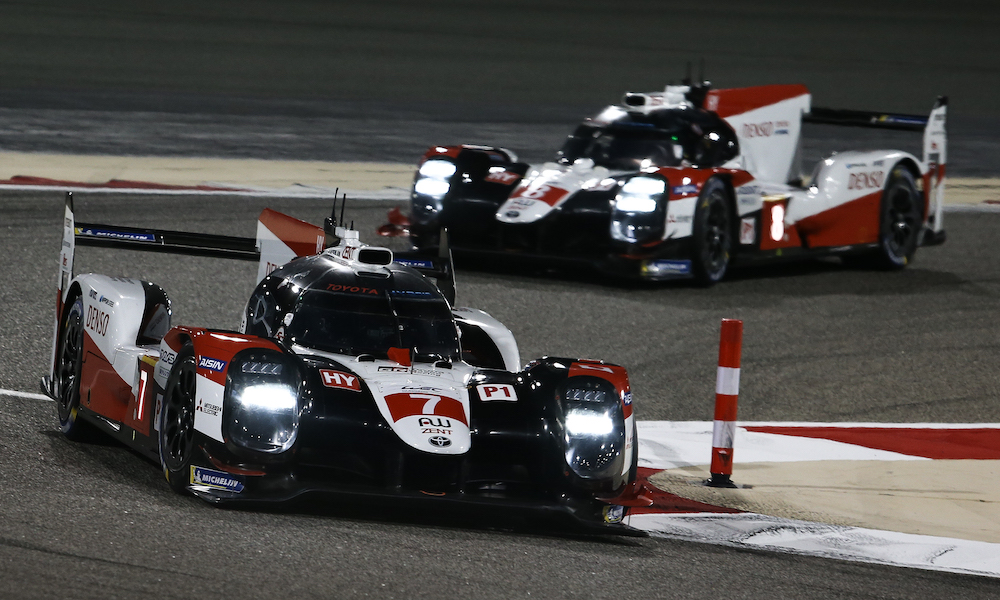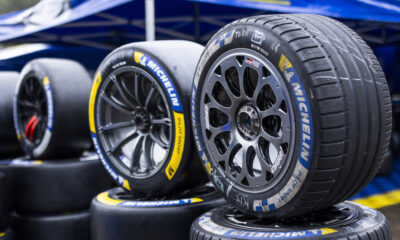
Photo: James Moy/Toyota
The No. 7 Toyota TS050 Hybrid will have a 0.54 second per lap advantage over its teammate No. 8 car following the confirmation of success handicaps for next weekend’s FIA World Endurance Championship title decider in Bahrain.
Different handicaps will be applied to the two Toyota Gazoo Racing machines despite them being the only LMP1 cars signed up for the eight-hour 2019-20 season finale.
However, the absence of any other competitors has led to a change in the way both Toyotas’ success handicaps are calculated.
The WEC’s latest LMP1 technical bulletin shows the No. 8 Toyota, which is ahead in the championship standings, on a handicap of 0.54 seconds per lap while its sister car’s success penalty has been zeroed.
At recent rounds the Toyota handicaps were formed using the points difference between each TS050 Hybrid and a ‘virtual car’ sitting 40 points behind the championship leader.
The virtual car rule was introduced ahead of last year’s 8 Hours of Bahrain when the gap between both Toyotas and the last-placed car in the table exceeded 40 points.
For Bahrain, the Rebellion and LNT Ginetta entries have been taken away from the technical bulletin, along with the need for a virtual car.
This means the handicap for the No. 8 Toyota of Le Mans winners Kazuki Nakajima, Sebastien Buemi and Brendon Hartley can be calculated using the difference to the lowest participating vehicle in the standings, which is the sister No. 7 machine.
Since the No. 7 Toyota of Jose Maria Lopez, Mike Conway and Kamui Kobayashi does not have any cars below it to calculate a difference against, its handicap is shown as zero.
The handicap amount is generated by multiplying the points difference by the length of the 5.412 km Bahrain International Circuit and a coefficient of 0.01255.
Removing the non-hybrid cars and the need for a virtual car has resulted in the two Toyotas receiving a minimum weight of 878 kg, which is 54 kg lighter than they have been running for most of the season.
They have also been given higher fuel flow allowances, larger refueling restrictors and breaks in how much energy their hybrid systems can expend over the course of a lap, with the amounts differing slightly to reflect the different handicaps.
Toyota has voiced its support for the continuation of handicaps despite no other teams taking part. Rebellion Racing announced that it would be skipping the season finale shortly after the 24 Hours of Le Mans, which marked its final race in the LMP1 category.
The 0.54s per lap handicap difference between the Toyotas would not have changed with the addition of the absent non-hybrid teams to the Bahrain technical bulletin.
“We fully agree to retain [a] success handicap for Bahrain; it is the only fair and sporting option,” said Toyota Gazoo Racing LMP1 technical director Pascal Vasselon.
“Remember that the success handicap is applied to individual cars, so it simply isn’t relevant that the Toyotas are the only LMP1 cars in Bahrain.
“The success handicap effect has to be considered over the course of a complete season, and so far this season the No. 7 car has been at a success handicap disadvantage in three of the six WEC races, against only one time for car No. 8, of course excluding Le Mans.
“So the championship standings going into Bahrain reflect the effect of the success handicap up until this last race; therefore it balanced and sporting to maintain the regulations for this championship-deciding race.”
The handicap bulletin puts the No. 8 on 174 points and the No. 7 on 166 points in the non-championship points table which decides how large each car’s penalty will be.
This unofficial leaderboard only takes into account points for race results, including Le Mans where handicaps were not enforced during the race and the Toyotas ran at 895 kg.
In the official world championship standings Buemi, Nakajima and Hartley lead Lopez, Conway and Kobayashi by seven points, or 175 points to 168.
The 8 Hours of Bahrain will mark the final race appearance of the four-year-old TS050 Hybrid, which is making way for Toyota’s new Le Mans Hypercar machine next season.
Bahrain GTE-Am Success Ballast Confirmed
The WEC has also released the final success ballast figures for the class this season.
AF Corse’s No. 83 Ferrari 488 GTE Evo of Nicklas Nielsen, Emmanuel Collard and Francois Perrodo is the heaviest at 1300 kg owing to its results over the past three races.
This car is second in the championship, four points behind the Le Mans-winning TF Sport Aston Martin Vantage GTE of Jonny Adam, Salih Yoluc and Charlie Eastwood.
The No. 90 Aston will be the second-heaviest car in Bahrain at 1282 kg, while two cars – the Ferraris from Red River Sport and the No. 54 AF Corse crew – are on 1270kg.
Both Team Project 1 Porsche 911 RSRs, the identical No. 88 Dempsey-Proton Racing Porsche and Gulf Racing’s 911 RSR are equal-lightest at 1229 kg.
























